

Here is a bay horse clearly showing this graduation of colour:

The following illustrations demonstrate how to achieve this look when colouring Kalidore Unicorns. Thumbnails are clickable!
Stage #1
In general, Kalidore unicorns are coloured with three basic colour layers:
Of course, you can use more then three layers of colour - I often do! - but I find three is the minimum you can get away with without having a rather dull, flat-looking unicorn... and nobody wants that XD
Stage #2
Pre-Mixed Colour - A Time-Saver:
Stage #3
If you're doing a bay-based or dun horse, now would be the time to also add the dark legs & points so that they can be blended into the counter-shaded colour.
In general, foals have much more counter-shading & pangre then adult horses, so never be afraid that you've added "too much colour"!
Stage #4
The Horses' Mouth: Don't forget to shade the muzzle if you haven't done so already. Remember - an undiluted horse has black skin; so wherever the fur is thinnest - around the eyes, nose/mouth, nether regions - that skin colour shows through. This is why horses appear to have dark grey or black muzzles and eyeliner. Some dilutions, like champagne or double-cream dilutes, give pink or mottled skin, so in those colours, those regions would be more peachy coloured. Of course, where there is a white marking - there is pink skin!
A Foot Note: Ensure that your hoof colour is corresponding with your leg colour - a coloured leg will have a grey or striped hoof (such as with appaloosas or silvers) while a white leg will have a shell-coloured hoof. Spots in the socks will also give colour on the corresponding part of the hoof; these are called ermine spots.
Light, Shadow, Magic: Last but not least, turn on the highlights & shadow layer. If needed, you can adjust the opacity of these layers to best suit the horse - turning down the shadows on very light horses, or the highlights on very dark ones. You will note that the shadow layer is not actually black, but a dark brown; this helps it blend in better with most natural horse colours. However, you may run against a colour (like blue!) wherein the shadow really clashes - to fix this, I simply use the hue/saturation/lightness toggle to adjust the shadow colour to something better. For instance, for champagne dilute horses, I'll often bump up the saturation to make it appear more red, to emulate the underlying peach-coloured skin.
Final Touches: When you're done, make sure everything is complete; does your horse have it shading layers? horn colour? eye whites? *G* It's always best to double-check BEFORE you save your file - it's such a pain to try and fix afterwards, lol!
Part Two: The Progression of Colour ~
Below are several common colours to help demonstrate typical colour progressions.
Standard Chestnut (with Sabino Markings) ~ The chestnut foal is generally very light and washed-out looking, with lots of pangre & counter shading, most of which is lost by the adult stage. As the foal grows, the colour brightens.
Black (with the presence of a Starburst breeding stone, providing dappling) ~ Black foals are often born varying shades muddy brown, which sheds out jet black as they grow. Note the Starburst Stone's influence becomes more apparent on the weanling stage. Black coats often have warm or cool tints to them & it's nice to had some hint of colour to the adult coat, so it's not just flat black.
Mahogany Bay ~ Bay foals are born with just a smudge of black on their legs, sometimes so pale they can be mistaken for chestnut! The black legs become visible with the first shedding. The influence of the sooty factor has darkened this bay into a shade known as "mahogany", and also provided some subtle dappling.
Grey (Dark) ~ In truth, every grey horse will end up snow white eventually! In Kalidore, we freeze the grey at whatever shade we see fit, for variety ;) Grey foals are born looking whatever their base colour is - but will have typically white "goggles" around the eyes and muzzle ring. Grey also always starts at the head and works it way down the horse - thus easily distinguishing a young grey from a roan, which always leaves the head dark. Interesting to note, grey foals are a more "mature" shade of colour at birth then their non-greying counterparts.
Palomino (Snowcap Appaloosa) ~ Palomino is chestnut with one cream gene influence, and comes in many shades besides the coveted "gold coin". Like chestnuts, the babies are born very pale and muted (often described as looking "pumpkin coloured", too!) The chestnut base also influences the shade - the sooty gene is responsible for darkening the colour and creating the chocolate tones, while light sorrels throw the pale, creamy "isabella" shades. Also note too how the appaloosa blanket is more detailed with each progressive stage.
Bucksin ~ I do love my sooty, lol! Buckskin is bay with one cream gene influence, and like palomino also comes in many shades from dark brown to pale gold. Cream in its single form only affects the red pigment, so the black points remain strong. Like bay babies, the foals can be born quite pale - some without any dark on their legs at all.
Grulla Dun (with the presence of the Brindle Stone, obscuring the dun markings) ~ Dun foals are born with dark legs and dark faces, and have very distinct dun factor markings - leg bars & dorsal striping. These may be less obvious on the adult, but are always present. Grulla is dun on black base; the more classic shade of dun is the dun dilution working on bay.
Silver Dapple (with the presence of a Starburst Stone, to provide dappling) ~ Silver is the opposite of cream, only affecting black bases, diluting them to dull mouse colours, taffys, and even cool flaxen. Silver babies are often born extremely pale, the intensity of the colour growing as the foal does.
Because foals are so small on their mother's certs, much of the detail that we'll see on the adult horse can be omitted - at the same time, they're great to practice on ;) My rule of thumb is to spare the detail on the foal, ensure it's indicated on the weanling, and bring it fully to life in the adult stage; this includes both colour, pattern detailing, and visibility of "sgenes" (ie, breeding stone effects).
Below you will find a sampling of details on real horses; I have always felt it was this attention to detail & accuracy which makes the Kalidore Unicorns stand out among PI horse adoptables and sets a bar for quality that few others have striven to meet!
At Left: A Mealy Muzzle ~ This bay pony displays the effects of heavy "pangre" around the eyes and muzzle. Pangre refers to the lightest areas of counter shading, and is commonly found in the more primitive breed types. Foals often show a great deal of pangre too. It often goes hand-in-hand with sooty shading, too.
Straight from the Horse's Mouth: We are naturally drawn to faces, so the detail of a Unicorn's head is quite important. And while Unicorns may have any eye colour, the other details are taken from nature. Since the hair on the eyes and muzzle is so thin, it lets the horse's skin colour show through, creating a different tone from the rest of the body. White markings naturally affect this too. Below are examples of common colours, and how that is expressed.
All About Hooves: Hoof detailing is a little thing, but a nice thing :D Generally, a coloured leg will have a grey hoof, and a white leg has a shell-coloured hoof. Black legs also tend to have darker grey hooves then chestnuts, and double dilutes will have paler, warm grey hooves. Appaloosa and Silver Dilute horses will have distinctive, vertically striped hooves.
Following Appaloosa: While there are several distinct patterns of appaloosa, there is one thing that all appaloosa spots have in common: they follows the horses' hairline. While more obvious in some patterns then others, following the hairline makes the difference between a realistic appaloosa pattern... and horse with a spotty behind XD For detailed hair growth, >click here<.
Dun vs Buckskin: The difference, of course, is in the details! While in real life the two can occasionally be tricky (and many people unknowingly label their photos incorrectly, too) we tend to make them quite distinct on Kalidore. Duns especially will have a lot of dun-factor barring & shading, regardless of base colour. To see coloured examples of the different shades of Dun, >click here<. Note the similarities - dark faces, legs, & counter-shading; dorsal stripes & leg barrings, tipped ears, subtle banding across the shoulder & frosted hair.
Part Four: Colour Modifiers Clarified ~
Paints & Pintos: Understanding White Patterns ~ There are five recognized genes that cause large white patches to eat up the horses' base colour leaving us with what is commonly termed "a painted horse". As our knowledge deepens, these categories are being split further, but for simplicity I will stick to the main five. To further confuse the matter, APHA (American Paint Horse Associations) clumps all the patterns into just two - Tobiano or Overo (which, in their eyes, seems to mean "not Tobiano" XD) Of course, Tobiano & Overo is simply one of the many patterns, all which will be exemplified below.
Sabino ~
Tobiano ~
Overo ~
Splash ~
Max White ~
Here's an easy way to remember the three most common patterns: "S" is for Sabino and Stockings, since Sabino is all about the stockings. "T" is for Tobiano and Top-line, since the Tobiano pattern always crosses the top of the horse. And "O" is for Overo and white that moves sideways over the horse.
Mixed Pinto Patterns ~ Naturally, breeding horses of different patterns together results in a mixing of patterns that can cause identifying the underlining genotypes quite tricky! For instance Tovero is Tobiano + any other white pattern - this can mean either Sabino, Splash, or Overo. A good way to spot combo types is knowing what each complex adds to the other. For instance, Sabino will boost white and add a "lacy edge" to the pattern; a sabino tobiano will have lots of white on the face and a sabino overo will have white legs - and both will have the clean, crisp edge of the colour broken up and the white even appear "splattered".
Paint Patterns in Kalidore ~ Luckily, paint patterns in Kalidore a less complex then in the real world! The general rule is: Sabino is prevalent in the breed, but remains in a minimal to moderate form; Tobiano is available through the use of the "Gypsy" breeding stone; Splash & Overo do not officially occur in the genepool, but two such individuals do exist - Lady Everlasting's Siro is an Overo, while Delicious' Rowen is a minimal Splash.
Mapping Appy ~ There are six different pattern of Appaloosa, and all occur on Kalidore (randomly assigned during breeding season). These patterns can occur on any base colour, and unlike paint patterns remain independent - so, you wouldn't have a horse expressing Leopard & Snowcap simultaneously. (Of course, appaloosa can combine with the paint patterns themselves, and that's a pintaloosa, and that's another story, lol).
On Kalidore, Blanket Appaloosa is the most common and is the iconic appy - a horse horse with a white spotted rump patch. This patch can be very collected, or so extensive it nearly covers the whole body. Next is Leopard, often nicknamed the "dalmation horse", white with spots all over. Varnish Roan (not to be confused with TRUE roan!) is often a mottled, marbled looking horse which may or may not have spotting within.
Snowcap is a distinct, solid white blanket that often has little to no spotting; the edge tends to be more distinct the blanket appaloosa, making the two patterns fairly recognizable. Frost/Snowflake is an indistinct dusting or splattering of white, and lastly, Fewspot which is a mostly white horse with pigmentation around the extremities with little to no spotting. Examples below are clickable!
Generally, appy patterns develop and grow with age, especially with certain blanket and varnish patterns; in Kalidore, we don't change the pattern too drastically between the stages, just for logistical reasons.
Fade to Grey ~ The first modern study of colour inheritance began with Thoroughbreds and the colour Grey; a grey horse must always have one grey parent, and all grey racehorses can trace their ancestry to the stallion Tetrarch. The greying coat develops over time; some breeds, like Arabians, grey very quickly. It can afflict any base colour, and express itself in a variety of ways, with colloquial terms used to describe these different shades.
Dapple Grey is the iconic colour, though any shade can dapple, and the effects are often seasonal. Steel Grey refers to any solid grey coat without dappling; occasionally it can be mistaken for roan. Light Grey (or "White") is the palest shade, which is the end result of the greying process. Fleabitten
is used to describe speckling or flecking that can develops on some greys. Rose Grey is any grey with warmer, rose tones; any reddish base colour can produce rose grey, such as chestnut or bright bay. And lastly, Mulberry Grey is the most uncommon shade, occurring when a chestnut horse greys in the body first, leaving the mane and tail brilliant auburn.
Of course, in the end all grey horses will end up "white" XD
Shading & Counter-Shading ~ The primary purpose of a horse's coat is to hide it from predators; counter-shading, stripes, and spots - all work to camouflage the animal and disguise its size. While Pangre is the lightening of the coat in the horses "soft areas", the sooty/or smutty factor works to darken the coat from the top down (and can add dappling, too). In extreme cases it can turn the entire horse black - even overriding cream to create on a chestnut base those elusive "black" palominos!
The first picture depicts a fairly Standard Bay; when soot is present, the topline darkens, and the shading becomes that much more intense - this is the second picture, and the shade is often called Mahogany Bay. The third picture is a horse so heavy with pangre the black of its leg points have been suppressed to below the feltlocks; this is refereed to as Wild Bay. This variation is most recognized in the Fjord breed, wherein Wild Dun is the standard of the breed.
Part Five: Helpful Links ~
Horse Colour & Markings Resource Pages ~ An excellent photo collection, clearly labeled & lots of examples.
Colourful Morgan ~ While created with educating Morgan owners in mind, it provides excellent coverage of basic genetics & lots of examples of more obscure colours in the Morgan breed, like Silver and Spash.
Dun Central Station ~ Everything you ever wanted to know about Dun (and false duns, too)
Champagne Horse Registry ~ Click on the "Champagne Colours" link to view hundreds of examples of Champagne in every variation, or the "Identification" link to see dozens of details. Helpful "what's not champagne" and "champagne +" galleries, too.
The Equine Tapestry ~ A really interesting blog about Horse genetics and occasionally other animals, too! (Plus it's quite new, so trekking back to the beginning is an easy read!)
UoK Trading Co: The Chibiquinn Rainbow ~ From the Kalidore Trading Cards, a wide variety of colours illustrated with brief descriptions of their genetic make-up. Good for looking up quick examples of colour.
Foal Colour Calculator ~ Wonder what bay x black equals? Chestnut x Cremello? This will tell you!
- the base colour, which is the lightest shade, or the "pangre" as seen on real horses;
- the main colour layer, which is "shade" of colour the horse is;
- and the final "counter shading" layer, or darkest shade (which can get very exaggerated in sooty horses) which truly makes the colour pop.
In the second illustration, we're adding our "body colour" layer of colour. In this case our example is sorrel, which is a chestnut horse which flaxen hair & points. Notice how the colour seems to run down over the foal's body; this emulates the natural lay of colour on a real horse.
To help make colouring easier, I have a pre-mixed pallet of colours I like to use to help achieve my various shades of horse. *G* I have a few nice sandy "pangre" shades mixed, several "chestnut" hues and at least a dozen variations of brown that layer well when building up a unicorn's colour. I also have pre-made hoof pallets, too - warm and cool greys, varying shades of "shell" for natural (flesh-coloured) hooves. While you still want to mix your colours up for diversity, I find having a few key base shades make colouring a lot of unicorns so much easier!
Since we're creating a light sorrel horse, our third colour layer is simply "dusted" into a few key spots - along the topline (back) of the horse, down the withers (shoulder), and a little dusting on the forehead and knees to help harmonize the colour.
At last, the fun part, the final details! Your colour is set, now is time to add any white markings - from stars & socks, to appy-spotting, pinto, or even roaning. These can be done on one layer or several, depending on the look you're going for and however it's most comfortable for you to work.

As the horse grows, its coat can undergo a myriad of changes. The foal coat is often very different from the adult shade, and it's often not until the first shedding (around five months) that the adult colour becomes clear. Some colours - like grey and some types of appaloosa - take years to develop fully. In Kalidore, foal colours are muted just like real horses, however, so not to complete confuse our breeders, we tend to keep them more recognizable then not; key indicators are always present, so with practice, all Kalidore foals - especially in the weanling stage - should be ultimately distinguishable.


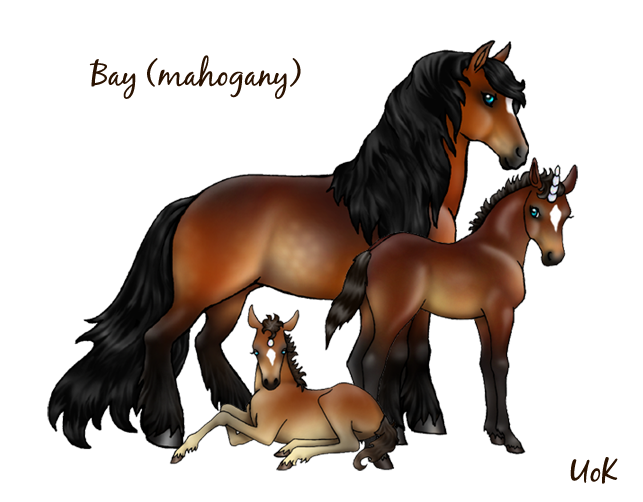
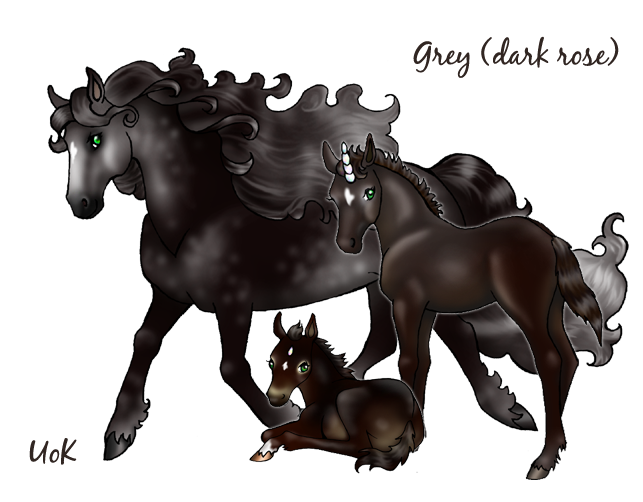
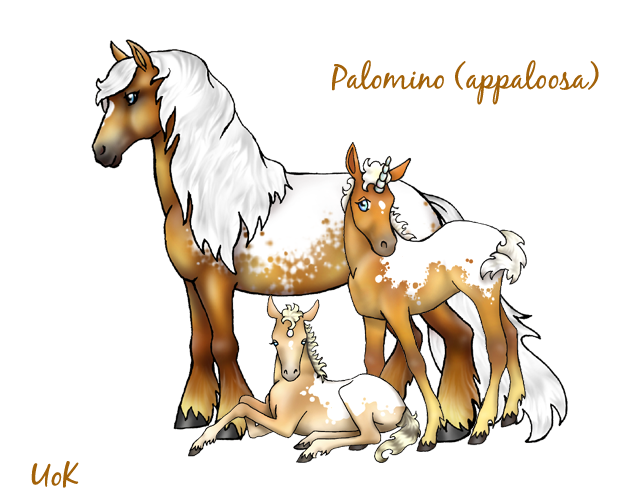
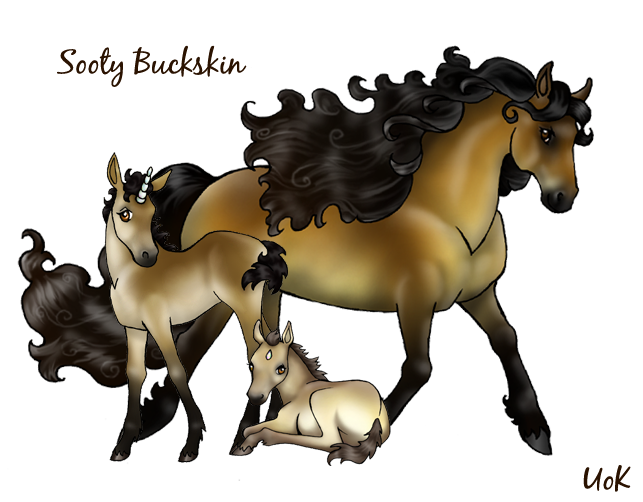

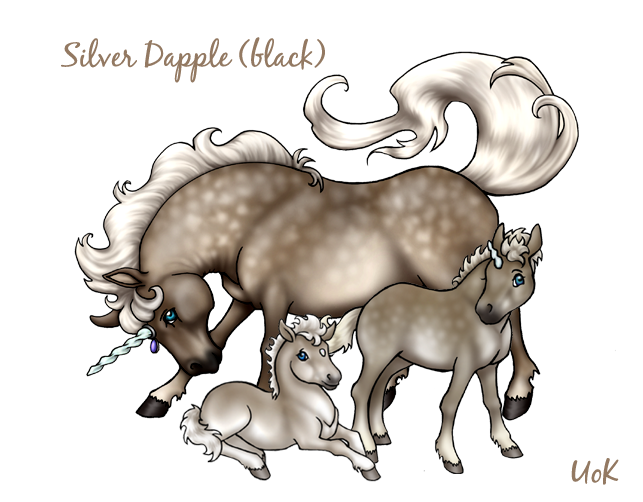

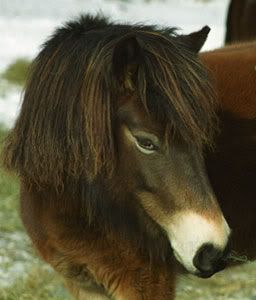
Part Three: The Devil in Details ~



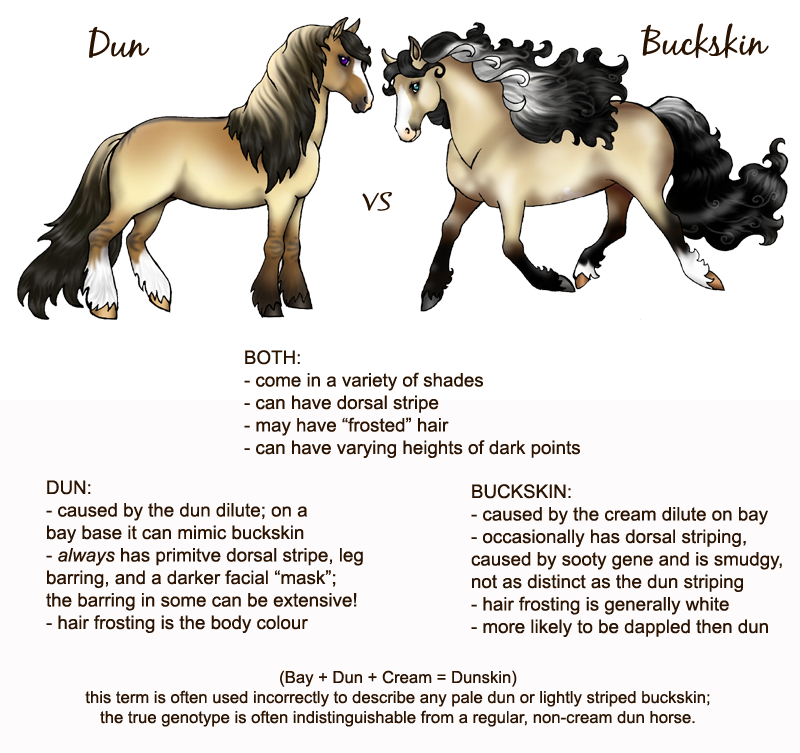

This is the basic white modifier believed responsible for stockings & blazes; the iconic sabino breed would be the Clydesdale. The white pattern of Sabino always moves from the bottom up - up the legs, under the belly, under the chin, as if the horse splattered with white paint below. Minimal Sabinos will simply have white legs and a blaze, while extensive examples can have ticking throughout their whole body (called Sabino Roans; again, not to be confused with TRUE roans!) In very loud examples, colour tends to remain on the crown of the head/ears (ie, "medicine cap") and base of the tail.
The pattern most people think of when they think of a painted horse, and is one of the oldest white patterns. In Tobiano, the pattern of white always crosses the top line of the horse (the length of the spine) and seems to move from the top of the horse down, as if white were spilled on the horse from above. The remaining coloured areas tend to be circular in shape, almost as if cut out with a large cookie cutter. Even in loud examples, colour remains on the head, flank, and chest.
A new-world mutation, and like Appaloosa, pattern synonymous with the old west. This pattern of white seems to move sideways across the horse, almost as if someone took an eraser and went to work on the animal's sides. It is also the only white pattern that can have solid legs, and even in minimal form Overo animals can have big, bald faces. Overo is also responsible for "lethal white" syndrome; if a foal receives two copies of the gene (one from each parent) the result is a solid white foal with an underdeveloped digestive track; these unfortunate animals live only a few hours, which makes genetic typing extremely important when breeding an Overo horse.
One of the rarer patterns, but also one that is very distinct - the Splash horse looks as though it has been dipped in a bucket of white paint from the bottom up! The edge of colour on a Splash horse is also very straight and clean-cut. While any white pattern can cause blue eyes where white crosses the face, Splash is known for strikingly beautiful minimal animals (ie, just a sock or a snip)white bright blue eyes on solid faces.
There are two genes responsible for an "all white" pinto; the first is Max Sabino (it's most extreme expression) and the other is Dominant White (DW). Recently being recognized as being it's own genotype, DW in its minimal form is, like Sabino, simply white legs and face and can easily be missed. Not to be confused albinism (which hasn't been documented in horses) or with Lethal Overo White, these white horses are viable, health, and can pop up from seeming minimal parents - providing much surprise for unknowing breeders!
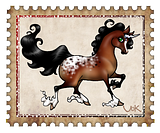

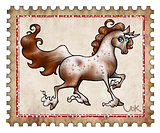
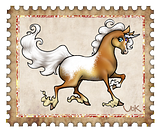

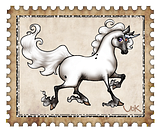
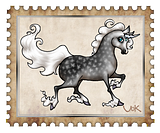

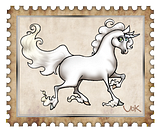
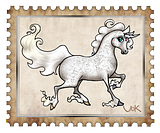

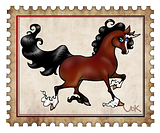
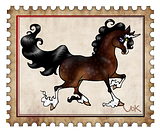
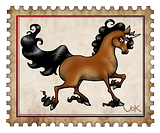

Because there's never such a thing as too many references, here's a collection of some of my favorite links :)
The Basics of Equine Color ~ Basic horse genetics made simple with great photos